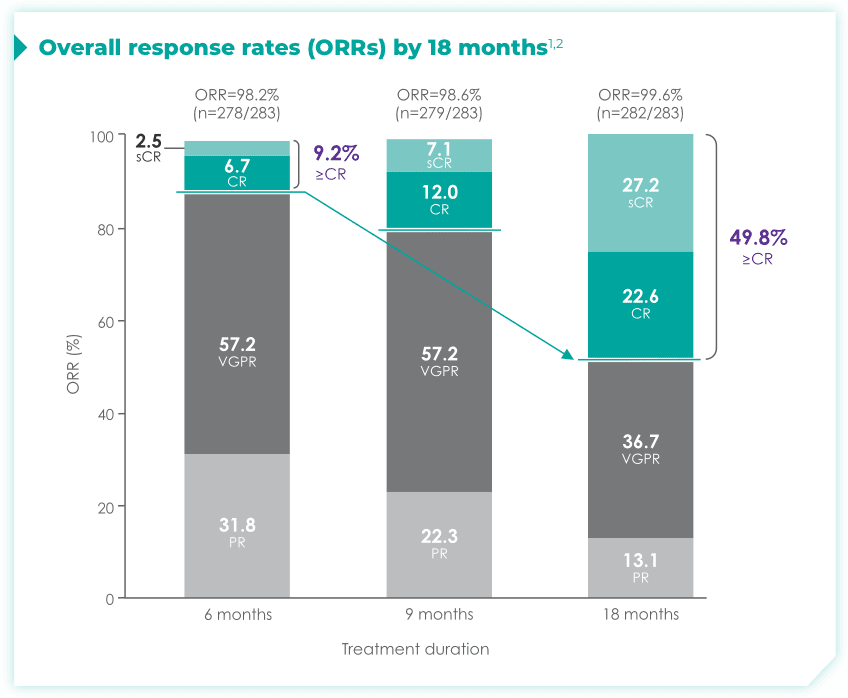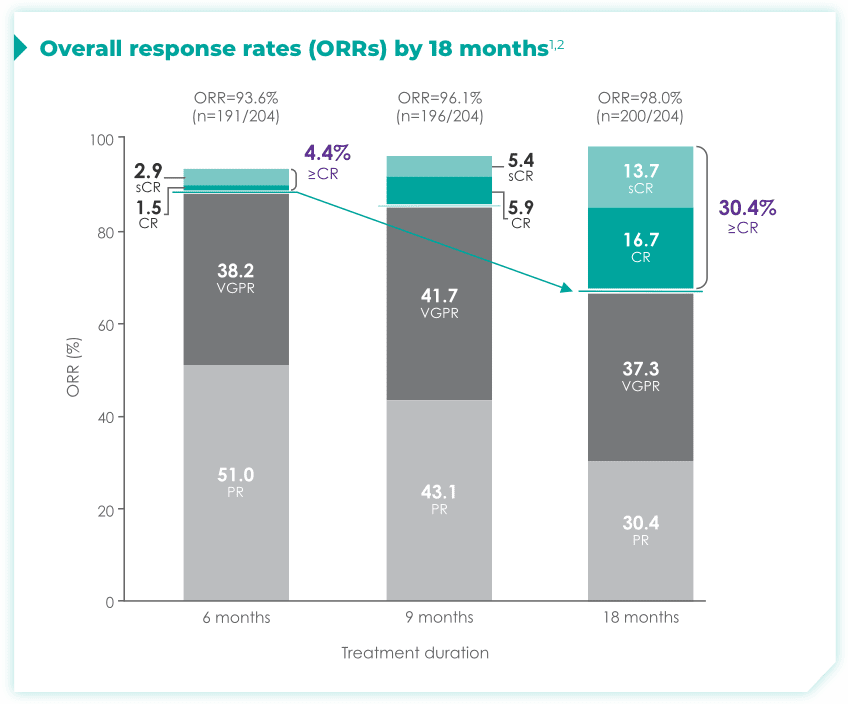You are now viewing a post hoc subset analysis by treatment duration of the MAIA trial. This information is not included in the current Prescribing Information and has not been evaluated by the US Food and Drug Administration. No conclusions should be drawn. These data should be understood in the context of the methodology.
- To explore the impact of treatment duration on long-term clinical outcomes, a post hoc analysis was conducted based on DRd treatment duration (<18 vs ≥18 months), excluding patients who discontinued therapy due to disease progression during the first 18 months1,2
- This post hoc subset analysis was based on patients who were treated for at least 18 months and excluded patients who discontinued therapy due to disease progression during the first 18 months1,2
- For the DRd arm, it included 283 patients who were treated for at least 18 months, out of 368 patients of the primary intent-to-treat (ITT) analysis of the MAIA trial. For the Rd arm, it included 204 patients who were treated for at least 18 months, out of 369 patients of the primary ITT analysis of the MAIA trial1-3
- Response data presented are cumulative deepest response rates achieved by 6, 9, and 18 months for patients who continued all study treatment for at least 18 months
≥CR rates increased over 6, 9, and 18 months of continuous frontline DRd.1,2
~50% of patients achieved a ≥CR by 18 months of DRd treatment compared with ~9% by 6 months of treatment1,2
~30% of patients achieved a ≥CR by 18 months of Rd treatment compared with ~4% by 6 months of treatment1,2
- Median duration of response was not reached with DRd vs 34.7 months (95% CI: 30.8-not estimable) for Rd alone†1
- Patients achieved longer duration of response with continuous DRd (a triplet regimen) vs continuous Rd (a doublet regimen)†3,4
You are now viewing a subset analysis by treatment duration of the MAIA trial. This information is not included in the current Prescribing Information and has not been evaluated by the FDA. No conclusions should be drawn. In the following analysis, treatment-emergent adverse events are presented as observed and should be understood in context with the specific methodology.
- Most frequently reported treatment-emergent adverse events (TEAEs) that met the threshold of cumulative any grade TEAE >30% or Grade 3/4 TEAE >10% are presented1
- Combined TEAE rates are the sum of the percentages of the most frequently reported TEAEs, at each cycle period
- Percentages represent number of patients with >1 TEAE by treatment cycle divided by total number of patients treated within the treatment window
- Only TEAEs with onset date falling within the cycle intervals were calculated. Each patient was calculated once per preferred term for each cycle interval. The same patient could be calculated in multiple cycle intervals and for multiple preferred terms. TEAEs may not have resolved by the next cycle
- Decrease in adverse event (AE) rates over time from treatment initiation was observed for most AEs in both treatment arms. Cataract tended to increase over time in both treatment arms (see rates below)1
- 13% of intent-to-treat (ITT) patients discontinued treatment due to a TEAE with DRd (n=364) vs 22% with Rd alone (n=365)2
AEs for DRd across Cycles 1-301
Any TEAE ≥30% or Grade 3/4 ≥10%
Scroll to view data over time
| DARZALEX® once-monthly administration start | |||||||||
|---|---|---|---|---|---|---|---|---|---|
| Any Grade TEAE | Cycles 1-2 (n=364) | Cycles 3-6 (n=348) | Cycles 7-10 (n=330) | Cycles 11-14 (n=312) | Cycles 15-18 (n=299) | Cycles 19-22 (n=285) | Cycles 23-26 (n=271) | Cycles 27-30 (n=259) | |
| Hematologic | Neutropenia | 40.4% | 24.4% | 17.9% | 18.6% | 17.7% | 16.1% | 11.1% | 12.4% |
| Anemia | 17.3% | 10.9% | 8.2% | 6.7% | 4.0% | 6.0% | 5.5% | 7.3% | |
| Leukopenia | 14.0% | 5.7% | 4.2% | 3.8% | 3.0% | 3.5% | 4.1% | 2.3% | |
| Lymphopenia | 13.7% | 4.6% | 3.6% | 4.8% | 5.7% | 4.2% | 4.4% | 3.5% | |
| Nonhematologic | Constipation | 26.4% | 11.8% | 5.5% | 3.8% | 4.0% | 2.1% | 3.0% | 5.0% |
| Nausea | 21.4% | 6.6% | 4.2% | 3.8% | 5.0% | 1.8% | 2.6% | 1.9% | |
| Fatigue | 20.1% | 14.1% | 7.0% | 8.7% | 7.4% | 7.7% | 5.9% | 7.3% | |
| Diarrhea | 15.9% | 15.5% | 15.8% | 16.0% | 18.4% | 17.5% | 14.0% | 10.0% | |
| Dyspnea | 14.8% | 6.6% | 3.9% | 3.2% | 1.7% | 3.2% | 2.2% | 2.3% | |
| Edema peripheral | 14.3% | 12.6% | 7.3% | 7.7% | 6.4% | 6.3% | 4.1% | 4.2% | |
| Cough | 14.0% | 6.9% | 3.9% | 2.9% | 3.0% | 4.2% | 4.8% | 3.1% | |
| Asthenia | 13.5% | 8.9% | 7.3% | 6.7% | 6.0% | 6.0% | 3.7% | 2.7% | |
| Muscle spasms | 13.5% | 9.5% | 2.1% | 5.4% | 2.3% | 2.5% | 2.6% | 1.2% | |
| Back pain | 9.9% | 6.3% | 6.4% | 5.1% | 4.0% | 6.7% | 3.7% | 5.4% | |
| Insomnia | 9.9% | 7.2% | 5.2% | 7.4% | 3.0% | 4.2% | 3.0% | 3.1% | |
| Weight decreased | 9.1% | 12.4% | 4.5% | 3.8% | 1.3% | 2.5% | 1.1% | 1.9% | |
| Hypokalemia | 8.0% | 4.6% | 3.3% | 1.6% | 3.0% | 6.0% | 2.2% | 4.2% | |
| Peripheral neuropathy | 6.3% | 4.0% | 5.2% | 5.4% | 5.4% | 7.0% | 2.6% | 3.1% | |
| Bronchitis | 4.7% | 6.6% | 6.4% | 7.1% | 8.7% | 6.7% | 6.6% | 7.3% | |
| Pneumonia | 4.7% | 6.6% | 3.9% | 4.2% | 4.7% | 5.3% | 3.3% | 2.3% | |
| Cataract | 0.3% | 0.6% | 2.4% | 3.5% | 5.4% | 3.9% | 3.7% | 4.6% | |
| Combined TEAE rates (sum of the percentages) | 292% | 186% | 128% | 130% | 120% | 123% | 94% | 95% | |
| Any Grade TEAE | Cycles 1-2 (n=365) | Cycles 3-6 (n=335) | Cycles 7-10 (n=297) | Cycles 11-14 (n=263) | Cycles 15-18 (n=237) | Cycles 19-22 (n=210) | Cycles 23-26 (n=187) | Cycles 27-30 (n=169) | |
|---|---|---|---|---|---|---|---|---|---|
| Hematologic | Neutropenia | 20.3% | 21.8% | 12.8% | 16.0% | 14.8% | 9.0% | 13.4% | 13.0% |
| Anemia | 19.5% | 16.1% | 8.1% | 8.0% | 10.1% | 5.7% | 3.7% | 5.3% | |
| Leukopenia | 4.4% | 2.4% | 1.3% | 3.0% | 3.0% | 2.4% | 2.7% | 4.1% | |
| Lymphopenia | 7.1% | 5.7% | 2.0% | 3.4% | 1.7% | 1.9% | 0.5% | 3.0% | |
| Nonhematologic | Constipation | 19.7% | 14.0% | 4.0% | 3.4% | 4.2% | 2.4% | 3.7% | 1.8% |
| Nausea | 15.6% | 6.0% | 4.0% | 2.3% | 2.1% | 3.8% | 2.1% | 0.0% | |
| Fatigue | 16.2% | 8.4% | 6.1% | 5.7% | 5.5% | 4.3% | 2.7% | 5.9% | |
| Diarrhea | 15.6% | 15.2% | 12.5% | 12.5% | 15.6% | 14.8% | 9.1% | 12.4% | |
| Dyspnea | 6.6% | 3.0% | 3.4% | 3.0% | 2.5% | 2.9% | 1.6% | 1.2% | |
| Edema peripheral | 11.8% | 12.5% | 6.4% | 3.8% | 5.5% | 6.7% | 4.8% | 4.7% | |
| Cough | 5.8% | 3.3% | 3.7% | 2.3% | 5.1% | 1.0% | 2.1% | 2.4% | |
| Asthenia | 9.6% | 5.7% | 6.4% | 4.2% | 5.1% | 3.3% | 2.7% | 5.9% | |
| Muscle spasms | 10.7% | 6.9% | 5.4% | 3.8% | 2.5% | 3.8% | 2.7% | 1.2% | |
| Back pain | 6.8% | 8.1% | 5.7% | 6.5% | 4.6% | 7.1% | 5.9% | 3.6% | |
| Insomnia | 12.6% | 9.3% | 6.7% | 5.7% | 5.1% | 2.9% | 2.1% | 4.1% | |
| Weight decreased | 7.1% | 6.6% | 2.7% | 1.5% | 4.2% | 2.9% | 1.6% | 1.2% | |
| Hypokalemia | 4.9% | 5.4% | 4.0% | 4.6% | 4.6% | 5.2% | 3.7% | 1.8% | |
| Peripheral neuropathy | 3.8% | 3.6% | 3.7% | 4.9% | 3.8% | 4.3% | 0.5% | 4.1% | |
| Bronchitis | 3.0% | 5.4% | 5.4% | 4.9% | 6.8% | 7.1% | 5.9% | 6.5% | |
| Pneumonia | 3.3% | 4.5% | 3.7% | 2.7% | 2.1% | 1.0% | 1.6% | 3.6% | |
| Cataract | 0.8% | 1.5% | 1.7% | 5.3% | 4.6% | 6.7% | 7.5% | 4.1% | |
| Combined TEAE rates (sum of the percentages) | 205% | 165% | 110% | 108% | 114% | 99% | 81% | 90% | |











